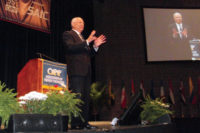
The baseline projection states that natural gas “will continue to play a major role in an increasingly competitive energy mix.” Gas demand is expected to grow from 21.9 quads in 1998 to 33.7 quads in 2015 (Figure 1).
However, the gas industry is going to have to adapt to a rapidly changing market structure and new competitors. With increased competition and tight margins, gas-electric industry consolidation will continue to look attractive. But the report says that this will be slow in coming.
Figure 1 shows that gas demand will grow in all sectors, but more than 50% of the growth will come from electricity generation. With a deregulated electric industry, there will be a number of smaller power plants as opposed to large centralized plants. This is “likely to place a greater emphasis on gas distribution and storage services.”
Along with a market in flux there will be price fluctuations. “Price volatility increased throughout the 1990s and is expected to persist in the future.”

Hearth grows fastest
Residential gas demand is forecasted to increase from 4.6 quads in 98 to 5.8 quads in 2015, growth of 1.4% a year (Figure 2). Histor-ically, residential growth has come from gas’ growing share of new home space heating. Gas space heating in new homes grew from 37% in 78 to 66% in 98.The GRI projection, though, indicates that gas space heating, although still the biggest segment, will remain relatively constant at the 98 level. Growth will come from other areas.
Since 1990, hearth products are the fastest growing residential gas category. This market is expected to continue to grow in the future. In total, “Growth in non-space heating applications is expected to add almost 600 trillion Btu of new gas demand by 2015.”

Space cooling expands
Commercial gas demand is predicted to see growth from 3.1 quads in 98 to 4.3 quads by 2015, an increase of 1.8% a year. Over 55% of the gas demand here is for space heating. But non-space heating categories, again, will show the strongest growth.All commercial applications will increase though 2015 (Figure 3). The largest percentage advances are expected for power generation and space cooling, the baseline projection notes.
There will be opportunities for onsite power generation in the commercial market. Gas demand for power generation will grow from 160 trillion Btu in 98 to more than 475 trillion Btu in 2015.
Due to equipment improvements and reduced cost, commercial space cooling is expected to make significant inroads. Gas cooling technologies include advanced double-effect gas absorption systems, large desiccant units, and large-tonnage engine chillers. Gas demand for space cooling is projected to increase from 120 trillion Btu in 98 to over 400 trillion Btu in 2015.
Publication date: 08/21/2000





